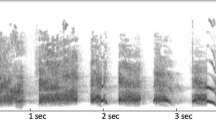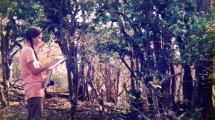Abstract
Social grooming and coalition formation have been main foci in studies concerning altruism in monkeys. Results have been inconclusive because the altruistic nature of these behaviors remains unclear. I investigated altruism in a more transparent context via an apparatus in which captive long-tailed macaque females had the choice to exploit a food source themselves or to yield the food to a test partner. I hypothesized that if potential donors behaved altruistically toward kin, they would yield the food sources longer to kin than to nonkin. Of 11 tested potential donors, 8 did not discriminate between daughters or sisters and nonkin. Thus, the experiments do not support the kin altruism hypothesis. Three females let their youngest offspring have more food than matched juvenile nonrelatives. Behavioral observations strongly suggested,however, that it was primarily spiteful behavior toward juvenile nonrelatives that caused the differences between kin and nonkin in these three cases.
Similar content being viewed by others
References
Alcock, J. (1989).Animal behavior. An Evolutionary Approach, 4th ed., Sinauer Associates, Sunderland, MA.
Altmann, S. A., and Shopland, J. M. (1987). Are baboons optimal interrupters?Am. J. Primatol. 12: 326.
Angst, W. (1974).Das Ausdrucksverhalten des Javaneraffen Macaca fascicularisRaffles. Fortschritte der Verhaltensforschorschung, Beihefte zur Zeitschrift für Tierpsychologie 15, Verlag Paul Parey, Berlin.
Angst, W. (1975). Basic data and concepts on the social organization ofMacaca fascicularis. In Rosenblum, L. A. (ed.),Primate Behavior. Developments in Field and Laboratory Research, Vol. 4, Academic Press, New York, pp. 325–388.
Bercovitch, F. B. (1988). Coalitions, cooperation and reproductive tactics among adult male baboons.Anim. Behav. 36: 1198–1209.
Bertram, B. C. R. (1982). Problems with altruism. In King’s College Sociobiology Group (ed.),Current Problems in Sociobiology, Cambridge University Press, Cambridge, pp. 251–267.
Bertrand, M. (1969).The Behavioral Repertoire of the Stumptail Macaque. A Descriptive and Comparative Study. Bibliotheca Primatologica 11, S. Karger, Basel.
Boccia, M. L., Reite, M., and Laudenslager, M. (1989). On the physiology of grooming in a pigtail macaque.Physiol. Behav. 45: 667–670.
Boesch, C, and Boesch, H. (1989). Hunting behavior of wild chimpanzees in the TaÏ national park.Am. J. Phys. Anthropol. 78: 547–573.
Bortz, J., Lienert, G. A., and Boehnke, K. (1990).Verteilungsfreie Methoden in der Biostatistik, Springer-Verlag, Berlin.
Brown, J. L. (1987).Helping and Communal Breeding in Birds. Ecology and Evolution, Princeton University Press, Princeton, NJ.
Chapais, B. (1988). Experimental matrilineal inheritance of rank in female Japanese macaques.Anim. Behav. 36: 1025–1037.
Cheney, D. L. (1983). Extrafamilial alliances among vervet monkeys. In Hinde, R. A. (ed.),Primate Social Relationships. An Integrated Approach, Blackwell Scientific, Oxford, pp. 278–286.
Clark, A. B. (1978). Sex ratio and local resource competition in a prosimian primate.Science 201: 163–165.
Dasser, V. (1988). A social concept in Java monkeys.Anim. Behav. 36: 225–230.
Datta, S. B. (1981).Dynamics of Dominance Among Rhesus Females, Ph.D. thesis, Cambridge University, Cambridge.
Datta, S. B. (1983a). Relative power and the acquisition of rank. In Hinde, R. A. (ed.),Primate Social Relationships. An Integrated Approach, Blackwell Scientific, Oxford, pp. 93–103.
Datta, S. B. (1983b). Relative power and the maintenance of dominance. In Hinde, R. A. (ed.),Primate Social Relationships. An Integrated Approach, Blackwell Scientific, Oxford, pp. 103–112.
Datta, S. B. (1983c). Patterns of agonistic interference. In Hinde, R. A. (ed.),Primate Social Relationships. An Integrated Approach, Blackwell Scientific Publications, Oxford, pp. 289–297.
Davies, N. B. (1978). Ecological questions about territorial behaviour. In Krebs, J. R., and Davies, N. B. (eds.),Behavioural Ecology. An Evolutionary Approach, Blackwell Scientific, Oxford, pp. 317–350.
Dawkins, R. (1982).The Extended Phenotype, W.H. Freeman, Oxford.
Dawkins, R. (1989).The Selfish Gene, new ed., Oxford University Press, Oxford.
de Waal, F. B. M. (1977). The organization of agonistic relations within two captive groups of Java-monkeys(Macaca fascicularis).Z. Tierpsychol. 44: 225–282.
de Waal, F. B. M. (1986). Class structure in a rhesus monkey group: The interplay between dominance and tolerance.Anim. Behav. 34: 1033–1040.
de Waal, F. B. M. (1991). Rank distance as a central feature of rhesus monkey social organization: A sociometric analysis.Anim. Behav. 41: 383–395.
Dittus, W. P. J. (1977). The social regulation of population density and age-sex distribution in the toque monkey.Behaviour 63: 281–322.
Dittus, W. P. J., and Ratnayeke, S. M. (1989). Individual and social behavioral responses to injury in wild toque macaques(Macaca sinica).Int. J. Primatol. 10: 215–234.
Dunbar, R. I. M., and Sharman, M. (1984). Is social grooming altruistic?Z. Tierpsychol. 64: 163–173.
Emlen, J. M. (1973).Ecology: An Evolutionary Approach, Addison-Wesley, Reading, MA.
Feistner, A. T. C, and McGrew, W. C. (1989). Food-sharing in primates: A critical review. In Seth, P. K., and Seth, S. (eds.),Perspectives in Primate Biology, Vol. 3, Today and Tomorrow’s, New Delhi, pp. 21–36.
Furuichi, T. (1983). Interindividual distance and influence of dominance on feeding in a natural Japanese macaque troop.Primates 24: 445–455.
Gadagkar, R. (1993). Can animals be spiteful?Trends Ecol. Evol. 8: 232–234.
Glick, B. B., Eaton, G. G., Johnson, D. F., and Worlein, J. (1986). Social behavior of infant and mother Japanese macaques(Macaca fuscata): Effects of kinship, partner sex, and infant sex.Int. J. Primatol. 7: 139–155.
Goodall, J. (1986).The Chimpanzees of Gombe. Patterns of Behaviour, Belknap Press, Cambridge, MA.
Goosen, C. (1987). Social grooming in primates. In Mitchell, G., and Erwin, J. (eds.),Comparative Primate Biology. Vol. 2B: Behavior, Cognition, and Motivation, Alan R. Liss, New York, pp. 107–131.
Gouzoules, S., and Gouzoules, H. (1986). Kinship. In Smuts, B. B., Cheney, D. L., Seyfarth, R. M., Wrangham, R. W., and Struhsaker, T. (eds.),Primate Societies, University of Chicago Press, Chicago, pp. 299–305.
Hamilton, W. D. (1963). The evolution of altruistic behavior.Am. Nat. 97: 354–356.
Hamilton, W. D. (1964a). The genetical evolution of social behavior. I.J. Theor. Biol. 7: 1–16.
Hamilton, W. D. (1964b). The genetical evolution of social behavior. II.J. Theor. Biol. 7: 17–52.
Hamilton, W. D. (1970). Selfish and spiteful behaviour in an evolutionary model.Nature 228: 1218–1220.
Hamilton, W. D. (1971). Selection of selfish and altruistic behavior in some extreme models. In Eisenberg, J. F., and Dillon, W. S. (eds.),Man and Beast: Comparative Social Behaviour, Smithsonian Institution Press, Washington DC, pp. 57–91.
Harcourt, A. H., and Stewart, K. J. (1989). Functions of alliances in contests within wild gorilla groups.Behaviour 109: 176–190.
Hunte, W., and Horrocks, J. A. (1987). Kin and non-kin interventions in the aggressive disputes of vervet monkeys.Behav. Ecol. Sociobiol. 20: 257–263.
Imakawa, S. (1988). Development of co-feeding relationships in immature free-ranging Japanese monkeys(Macaca fuscata fuscata).Primates 29: 493–504.
Kaplan, J. R. (1978). Fight interference and altruism in rhesus monkeys.Am. J. Phys. Anthropol. 49: 241–250.
Kawamura, S. (1965). Matriarchal social ranks in the Minoo-B troop. A study of the rank system of Japanese monkeys. In Imanishi, K., and Altmann, S. A. (eds.),Japanese Monkeys. A Collection of Translations, Altmann, S. A., at the University of Alberta, Edmonton, pp. 105–112.
Kummer, H., and Cords, M. (1991). Cues of ownership in long-tailed macaquesMacaca fascicularis.Anim. Behav. 42: 529–549.
Kurland, J. A. (1977).Kin Selection in the Japanese Monkey. Contributions to Primatology 12, S. Karger, Basel.
Markowitz, H. (1975). Analysis and control of behavior in the zoo.Research in Zoos and Aquariums, National Academy of Sciences, Numbered Series and Annual Proceedings AAZPA.
Massey, A. (1977). Agonistic aids and kinship in a group of pigtail macaques.Behav. Ecol. Sociobiol. 2: 31–40.
Massey, A. (1979). Reply to Kurland and Gaulin.Behav. Ecol. Sociobiol. 6: 81–83.
Maynard Smith, J. (1964). Group selection and kin selection.Nature 201: 1145–1147.
Netto, W. J., and van Hooff, J. A. R. A. M. (1986). Conflict interference and the development of dominance relationships in immatureMacaca fascicularis. In Else, J. G., and Lee, P. C. (eds.),Primate Ontogeny, Cognition and Social Behaviour, Cambridge University Press, Cambridge, pp. 291–305.
Nissen, H. W., and Crawford, M. P. (1936). A preliminary study of food-sharing behavior in young chimpanzees.J. Comp. Psychol. 22: 383–419.
Ratnayeke, A. (1991). Influence of kinship on the social behaviour between young and adult toque macaques(Macaca sinica) in the wild. In Ehara, A., Kimura, T., Takenaka, O., and Iwamoto, M. (eds.),Primatology Today. Proceedings of the XIIIth Congress of the International Primatological Society Nagoya and Kyoto, Elsevier Science, Amsterdam, pp. 137–140.
Rowell, T. E., and Hinde, R. A. (1962). Vocal communication by the rhesus monkey(Macaca mulatto).Proc. Zool. Soc. London 138: 279–294.
Schaub, H. (1994).Food-Sharing Experiments on Long-Tailed Macaques, Ph.D. thesis, University of Zurich, Zurich.
Shopland, J. M. (1987). Food quality, spatial deployment, and the intensity of feeding interference in yellow baboons (Papio cynocephalus).Behav. Ecol. Sociobiol. 21: 149–156.
Silk, J. B. (1982). Altruism among femaleMacaca radiata: Explanations and analysis of patterns of grooming and coalition formation.Behaviour 79: 162–188.
Silk, J. B. (1983). Local resource competition and facultative adjustment of sex ratios in relation to competitive abilities.Am. Nat. 121: 56–66.
Silk, J. B. (1986). Social behavior in evolutionary perspective. In Smuts, B. B., Cheney, D. L., Seyfarth, R. M., Wrangham, R. W., and Struhsaker, T. (eds.),Primate Societies, University of Chicago Press, Chicago, pp. 318–329.
Sokal, R. R., and Rohlf, F. J. (1981).Biometry. The Principles and Practice of Statistics in Biological Research, W. H. Freeman, New York.
Stammbach, E. (1988). Group responses to specially skilled individuals in aMacaca fascicularis group.Behaviour 107: 241–266.
Starin, E. D. (1978). Food transfer by wild titi monkeys (Callicebus torquatus torquatus).Folia Primatol. 30: 145–151.
Struhsaker, T. T. (1967). Social structure among vervet monkeys.Behaviour 29: 83–121.
Strum, S. C. (1975). Primate predation: Interim report on the development of a tradition in a troop of olive baboons.Science 187: 755–757.
Sugiyama, Y., and Ohsawa, H. (1982). Population dynamics of Japanese monkeys with special reference to the effect of artificial feeding.Folia Primatol. 39: 238–263.
van Hooff, J. A. R. A. M. (1967). The facial displays of catarrhine monkeys and apes. In Morris, D. (ed.),Primate Ethology, Aldine, Chicago, pp. 7–68.
Walters, J. R., and Seyfarth, R. M. (1986). Conflict and cooperation. In Smuts, B. B., Cheney, D. L., Seyfarth, R. M., Wrangham, R. W., and Struhsaker, T. (eds.),Primate Societies, University of Chicago Press, Chicago, pp. 306–317.
Wilson, E. O. (1975).Sociobiology. The New Synthesis, Belknap Press, Cambridge, Mass.
Yamada, M. (1963). A study of blood-relationship in the natural society of the Japanese macaque.Primates 4: 43–65.
Author information
Authors and Affiliations
Rights and permissions
About this article
Cite this article
Schaub, H. Testing kin altruism in long-tailed macaques (Macaca fascicularis) in a food-sharing experiment. Int J Primatol 17, 445–467 (1996). https://doi.org/10.1007/BF02736631
Received:
Accepted:
Issue Date:
DOI: https://doi.org/10.1007/BF02736631




